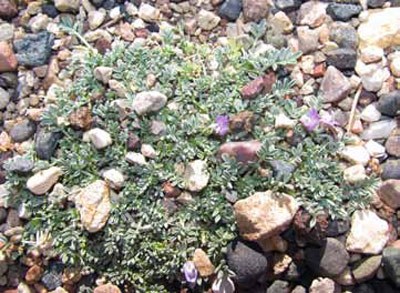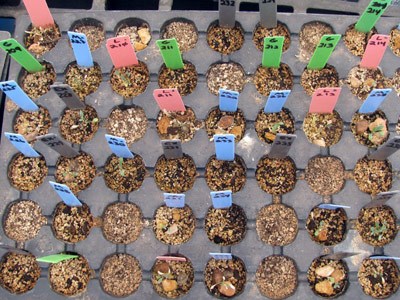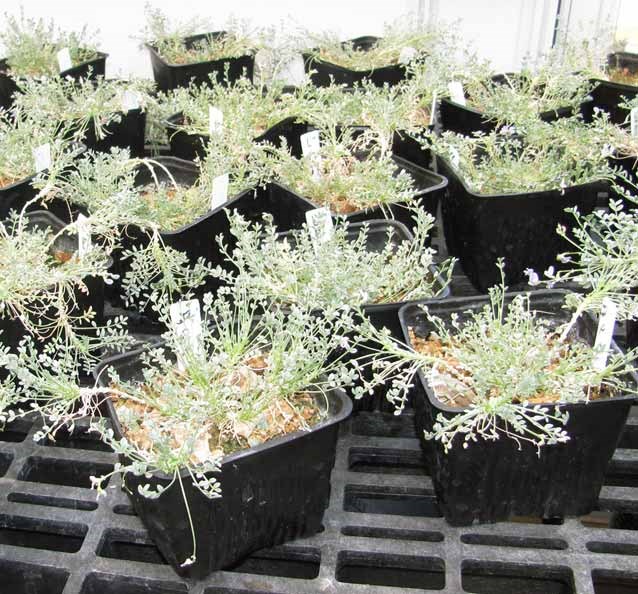Part of a series of articles titled Recovering the Endangered Sentry Milk-Vetch in Grand Canyon National Park.
Article
Recovering the Endangered Sentry Milk-Vetch, Methods & Preliminary Results
- Duration:
- 8 minutes, 10 seconds
The tiny, federally endangered sentry milk-vetch (Astragalus cremnophylax var. cremnophylax) is a perennial herb that forms a one inch tall by eight inch wide mat in shallow pockets of soil on the Kaibab limestone. It is endemic to the Grand Canyon, and only grows within 25 feet of the canyon rim. Since 2006, when the Sentry Milk-Vetch Recovery Plan was completed, Grand Canyon National Park has partnered with the U.S. Fish and Wildlife Service, the Arboretum at Flagstaff, and the Grand Canyon Association to reverse the decline of this species.

Grand Canyon National Park / NPS
Introduction and Background
The tiny sentry milk-vetch plant (Astragalus cremnophylax var. cremnophylax) is federally listed as an endangered species and is endemic to Grand Canyon National Park. Displaying lavender blooms in the spring and fall, this perennial herb forms a one inch tall by eight inch wide mat in pockets of shallow soil on the Kaibab limestone. Growing only within 25 feet of the canyon rim, this tiny plant overlooks the canyon, earning its name, “sentry”. Since 2006, when the Sentry Milk-Vetch Recovery Plan was completed in accordance with the Endangered Species Act, Grand Canyon National Park has partnered with the U.S. Fish and Wildlife Service, the Arboretum at Flagstaff, and the Grand Canyon Association to reverse the decline of this species.
Methods
The project takes a multi-faceted approach to meeting recovery plan objectives, from identifying and protecting existing populations to establishing new ones.
Protecting habitat
Since the 1980s, Grand Canyon National Park staff have been surveying potential habitat along both the North and South Rims of the canyon to look for new populations. Over the last decade, specialists have been searching for suitable areas in which to reintroduce the plant.
Protecting existing populations
Researchers have identified three populations of sentry milkvetch (one of them very small), all on the South Rim of the Grand Canyon. The largest population exists at Maricopa Point, where installation of fencing in 1990, removal of the parking lot in 2008, and re-routing of the asphalt visitor pathway have created a buffer from visitor impacts. Staff monitor existing sentry milk-vetch populations every year.
Researching optimal growing conditions
Experimenting with propagation techniques to grow ex situ (off-site) populations and to enhance germination and survival of plants in the wild are important elements of the recovery effort. In 2009, the park built a passive solar greenhouse to grow the sentry milk-vetch in controlled conditions. In both greenhouse and natural populations, horticulturist Janice Busco experimented with several factors that may affect plant germination and survival, including light levels, pollination methods, soil planting depths, seedling protection and watering intervals.

Grand Canyon National Park / NPS
The Arboretum at Flagstaff has also been experimenting with how best to grow these plants, beginning with their sentry milk-vetch seed germination studies in 1989, and continuing with their current research to compare the vigor of seeds between two of the known wild populations and from crosses of the two.
Results and Discussion
Grand Canyon National Park staff and their collaborators are steadily growing their stock of sentry milk-vetch plants and seeds. They are also improving germination and survival rates of plants reintroduced into the wild. This foundational work is essential for meeting the goals of the recovery plan, which requires four self-sustaining populations of at least 1000 individuals before the species can be downlisted from endangered to threatened.
Experiments to improve growing techniques continue, but the planting stock now available from ex situ propagation in the Grand Canyon National Park greenhouse is up to 225 plants as of early 2013, providing seeds and seedlings for reintroduction to the wild. These greenhouse seeds and plants are being used in reintroduction trials that started in 2011 at the Maricopa Point restoration site.
An exciting restoration milestone was reached in 2012 when staff discovered the first seedling progeny of 2011 plantings at Maricopa Point. At least 50 of the 102 tiny seedlings found were a direct measure of the reintroduction efforts. Plant survival and seed germination rates are also encouraging. Approximately half of the 255 seeds planted in the wild in 2012 at Maricopa Point successfully germinated into seedlings. Additionally, 41 of the 80 sentry milk-vetch planted the year before, in 2011, are still alive and thriving.
As of 2013, the sentry milk-vetch recovery project is still in progress, with the support of three additional years of funding obtained in 2012. Staff will focus on establishing two new reintroduction sites in suitable habitat, and will continue their propagation and experimentation work. Ongoing efforts will be focused on informing and engaging the public through a variety of media and hands-on volunteer opportunities.

Grand Canyon National Park / NPS
Contact and Sources
Project Contact
Lori Makarick
Vegetation Program Manager, Grand Canyon National Park, lori_makarick@nps.gov
Sources
Grand Canyon National Park. 2010. Grand Canyon achieves milestone in recovery of endangered plant. Park News online. Accessed from https://www.nps.gov/grca/learn/news/2010-03-24_smv.htm
Grand Canyon National Park. 2010. Grand Canyon National Park takes steps to recover the endangered sentry milkvetch. Canyon Sketches Vol. 16, January, 2010, online, accessed from https://www.nps.gov/grca/naturescience/cynsk-v16.htm
Prepared by Sonya Daw and Jean Palumbo, Southern Colorado Plateau Network Inventory and Monitoring Program, 2013.
Last updated: May 18, 2018
